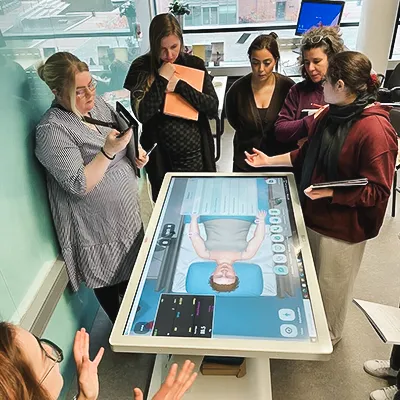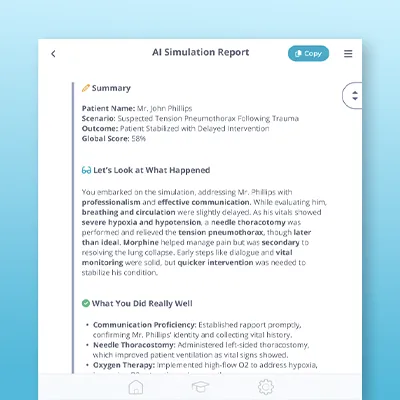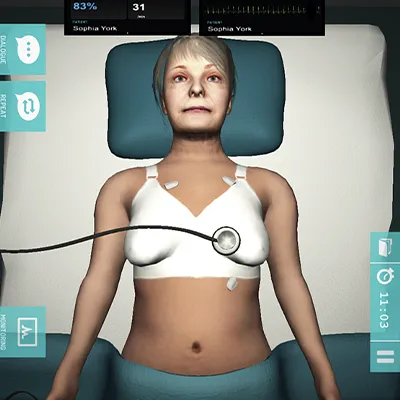Webinar: Head-to-Toe Physical Examination Approach
Body Interact introduced a new feature with immense pedagogical value in a recent webinar: the Head-to-Toe physical examination approach.
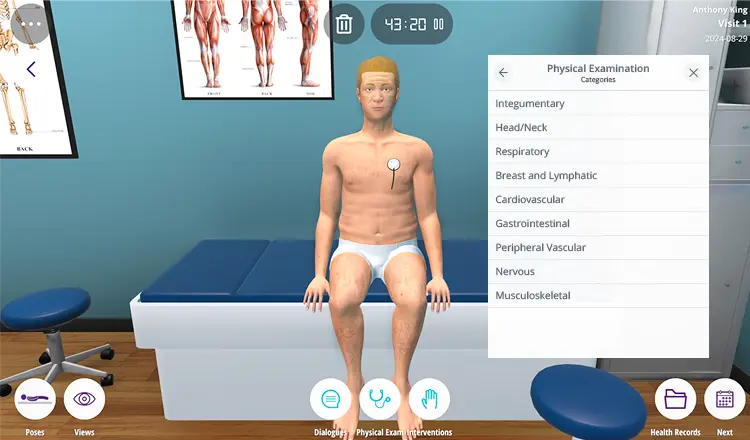
What is the Head-to-Toe Physical Examination Approach?
The head-to-toe physical examination is a comprehensive, systematic method for gathering detailed patient information to assess health status accurately. This approach involves thoroughly examining the entire body, enabling healthcare providers to identify existing or potential health issues. It helps healthcare providers gain essential insights into the patient’s overall physical condition, supporting an informed treatment plan and addressing any health concerns proactively.
Why move towards the Head-to-Toe Approach to conduct a patient physical examination to the detriment of the ABCDE approach?
In clinical practice, both the Head-to-Toe and ABCDE (Airway, Breathing, Circulation, Disability, Exposure) approaches play crucial roles in patient assessment, each serving distinct purposes depending on the patient’s condition and the context of the examination:
- ABCDE approach should be used when a patient is deteriorating or critically ill and presenting acute distress, trauma, or symptoms suggesting imminent physiological collapse.
- Head-to-Toe approach is appropriate when patients are stable, and the focus is on a comprehensive assessment, preventive care, or chronic disease management.
What will users encounter in Body Interact scenarios?
As discussed previously and highlighted in the webinar, Body Interact users will continue to encounter the ABCDE approach in critical scenarios. However, in Consultation scenarios, users will now find the Head-to-Toe assessment approach.
In these Consultation scenarios, the virtual patient can now be assessed thoroughly across the following systems:
- Integumentary System
- Head and Neck
- Respiratory System
- Breast and Lymphatic System
- Cardiovascular System
- Gastrointestinal System
- Peripheral Vascular System
- Genitourinary and Reproductive System
- Nervous System
- Musculoskeletal System
What are the pedagogical benefits of using the Head-to-Toe approach?
The Head-to-Toe approach to physical examination in healthcare-based curricula offers several pedagogical benefits that enhance learning and practice for healthcare students, including:
- Promotes systematic learning, helping students develop an organized and logical flow in their examination technique;
- Reinforces clinical reasoning, allowing students to correlate clinical findings with anatomical and physiological knowledge;
- Emphasizes a comprehensive understanding of the patient as a whole rather than focusing on isolated systems or symptoms;
- Establishes a standardized method of conducting physical examinations, which is critical for students who are developing their clinical skills;
- Integrates students’ theoretical knowledge of anatomy, physiology, and pathophysiology with practical assessment skills;
- Encourages the application of skills learned in the classroom – such as auscultation, palpation, and inspection;
- Builds confidence and competence, including recognizing abnormal findings, making clinical judgments, and understanding how different findings relate to potential diagnoses;
- Enhances interdisciplinary communication, as students can present their findings in a structured way that aligns with the expectations of other healthcare professionals;
- Promotes a patient-centered approach focusing on patient safety and increasing awareness of the patient’s overall condition.
In addition to benefiting the students, the Head-to-Toe approach offers advantages for educators:
- Instructors can use the Head-to-Toe approach as a clear and structured framework for teaching physical examination techniques, simplifying the complex task of patient assessment and making it easier for students to understand and practice.
- Educators can assess students’ proficiency more easily using a standardized checklist based on the Head-to-Toe approach, allowing for objective evaluation of the students’ thoroughness, accuracy, and technique during physical exams.
Incorporating the Head-to-Toe approach into healthcare-based curricula provides a comprehensive, structured, and patient-centered framework for teaching physical examination. It ensures that students not only develop the clinical skills necessary for competent healthcare practice but also gain a deeper understanding of the human body, pathologies, and patient interaction. The approach enhances clinical reasoning, promotes thoroughness, and fosters consistency, making it an essential pedagogical tool in healthcare education.
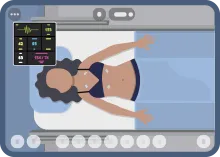
Curious to learn more or explore our new head-to-toe examination feature?
Don’t hesitate to contact us anytime!
References
Bickley, L. S., Szilagyi, P. G., Hoffman, R. M., & Soriano, R. P. (2021). Bates’ guide to physical examination and history taking, 13e. Lippincott Williams & Wilkins, a Wolters Kluwer business.
Huber, B. J., & Epp, S. M. (2022). Teaching & learning focused physical assessments: An innovative clinical support tool. Nurse education in practice, 59, 103131. https://doi.org/10.1016/j.nepr.2021.103131
Doyle, G., & McCutcheon, J. (2015). Clinical Procedures for Safer Patient Care. Ottawa: Canadian Association of Schools of Nursing.
Resuscitation Council UK (2024). The ABCDE Approach.
Gaines, K. (2024, April 5). How to conduct a nursing head-to-toe assessment. Nurse.org.


